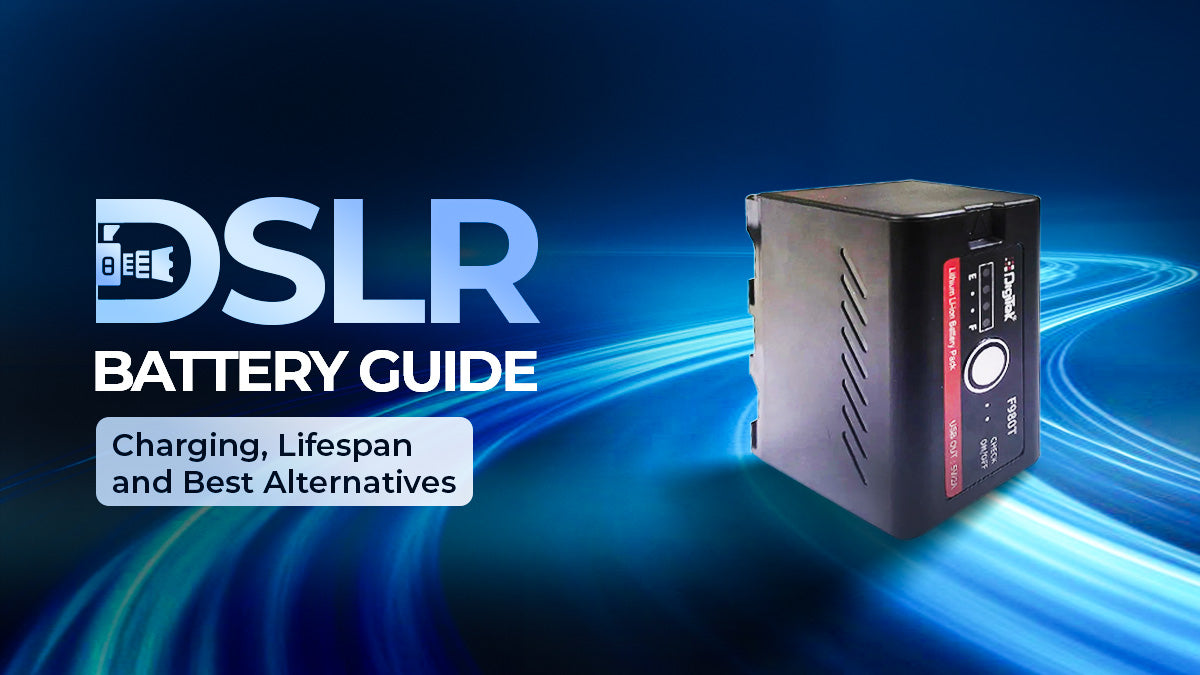For avid photographers, a DSLR camera is not just an instrument to capture those wondrous moments in life, but it's also a companion. One of the most vital components of owning a DSLR camera is to ensure that it's always ready to go when you need it. Ensuring that your camera is always ready to go begins with the battery. Knowing how to properly charge a DSLR battery, how long the battery lasts, and how to extend its life will help you avoid that agonising moment when you're out of power in the middle of a shoot.
This guide will give you insight into how to charge DSLR batteries, how long batteries last and look at some of the best alternatives to OEM batteries. Whether you are a casual photographer or a professional, ensuring that your battery is healthy and that you're using the right battery will keep you photographing for longer with your camera.
How to Use a DSLR Without Battery
Using a DSLR camera without a battery might sound impossible, but there are a few reliable ways to keep it running when your battery runs out.
One of the most effective methods is to power your camera externally using an AC adapter or a dummy battery. A dummy battery fits into your camera’s battery slot and connects to an AC adapter that plugs into a wall outlet, allowing you to use the camera without draining a regular battery. This setup is ideal for studio environments or locations where a wall outlet is easily accessible.
If you’re shooting remotely or on a multi-day outdoor assignment, consider using a power bank. Many modern DSLRs support USB charging, allowing you to connect your camera directly to a power bank. This is a convenient solution when you’re travelling or working in areas without access to a wall socket. If your camera supports USB charging, you can also recharge the battery directly through the same port.
Lastly, if you don’t have a charger handy, pairing a dummy battery with an adapter is another great way to power your DSLR continuously without relying on the standard battery.
How to Charge a DSLR Battery
Properly charging your DSLR battery is crucial for maintaining its health and ensuring consistent performance. Always use the correct charger designed for your camera’s specific battery type. Avoid unreliable third-party chargers, and if you must use one, make sure it’s from a reputable brand. Using a charger with the wrong voltage or charge rate can damage the battery’s internal components and shorten its lifespan.
Once you’ve selected the appropriate charger, insert the battery and connect the charger to a wall outlet or a compatible power source, depending on your camera model. Make sure to charge the battery in a cool, dry environment, as excessive heat can significantly reduce battery life. Most chargers feature an indicator light that shows when the battery is fully charged, though this may vary by model.
Typically, a DSLR battery takes about 1.5 to 2 hours to charge fully. Avoid overcharging the battery; once it reaches 100%, unplug it to prevent any strain on the battery's internal structure.
How Long Does a DSLR Battery Last?
The battery life of a DSLR depends on various factors, such as the type of battery, the model of the camera, and how it’s being used. On average, a DSLR battery can last between 500 and 1,000 shots on a full charge. However, this estimate can fluctuate based on the settings you’re using.
If you utilise your camera in live view mode, to record video, or to take continuous shots, your battery may drain much faster than when using your viewfinder. Temperature can greatly influence battery performance as well; when it's cold outside, battery performance decreases significantly and drains quickly than usual.
To maintain your DSLR battery, consider leaving it in the 20%-80% range and try to avoid fully depleting it if possible. This helps minimise battery degradation and increases efficiency.
How Long to Charge a DSLR Battery
Charging your DSLR battery typically takes around 1.5 to 2 hours, depending on the battery's capacity and the charger used. If you’re using a high-quality charger, it will automatically stop charging when the battery reaches full capacity to prevent overcharging.
When charging your battery, it’s a good idea to let it charge completely before use, especially if you’re preparing for a long shoot. This ensures that you have the maximum charge possible, so you’re less likely to run out of power mid-shoot.
How Many Hours to Charge a DSLR Battery
The time required to charge a DSLR battery varies based on the capacity of the battery and the power output of the charger. In general, batteries for most DSLRs will take 1.5 to 2 hours to charge fully. Higher-capacity batteries, such as professional camera batteries, will usually take longer to charge, especially if significantly drained.
If you’re in a hurry and need a quick charge, some chargers offer fast-charging technology. However, frequent use of fast-charging can reduce the overall lifespan of the battery, so it’s recommended to use this feature sparingly.
How to Charge a DSLR Battery with Power Bank
For photographers who are on the move, using a power bank to charge a DSLR battery could be a great option. If your DSLR camera is USB chargeable, you can plug it into the power bank using the appropriate USB cable. This can be very helpful in an outdoor shoot or when you are travelling somewhere.
When choosing a power bank to charge your DSLR battery, make sure it has enough capacity to support your camera’s power needs. As a general rule, opt for a power bank with at least 10,000mAh capacity so you can charge your camera multiple times without interruption. Using a power bank is a convenient way to extend your shooting time, especially during travel or outdoor sessions, while eliminating the need for bulky charging equipment. It offers a compact, portable, and efficient power solution for photographers on the go.
How to Charge a DSLR Battery Without Charger
In case you don’t have a way to charge your battery with a charger, there are several other ways you can charge it without a charger. If your camera has USB charging, you can use a USB cable. This feature is becoming more common in newer DSLR cameras, and USB charging allows you to charge your battery using an outlet on a computer or use a car charger or power bank.
Another way is to use an AC adapter with a dummy battery. Dummy batteries offer a solution for providing continuous power to the camera. This is especially useful for studio shoots or any shooting where you do not want to change out batteries. Shows, shoots, and long-term consumption of energy connecting dummy batteries are helpful. Dummy batteries are easy to find for almost every style of DSLR camera, and can provide power when there is no outlet or charger available.
Which DSLR Battery is Best?
When it comes to choosing the best DSLR battery, it largely depends on your camera’s brand and model. You’ll need to select a battery that’s compatible with your DSLR’s specifications. Here are a few options we recommend:
Digitek (Platinum FW-50) – Compatible with Sony Alpha NEX series and DSLR-SLT-A33/A55
The Digitek (Platinum FW-50) is a premium quality lithium-ion rechargeable battery designed for use with Sony DSLR cameras, including the Sony Alpha NEX series and the DSLR-SLT-A33/A55. This battery has a high capacity and delivers long-lasting performance, which makes it the perfect option when shooting for extended sessions, whether for landscapes, portraits, or capturing events. It's a great option for photographers who need reliable power for long, uninterrupted shooting experiences.
Digitek (LP-E17) – For Canon EOS 750D, 800D, and 77D
The Digitek (LP-E17) is a rechargeable lithium-ion battery made for Canon DSLR cameras such as the EOS 750D, EOS 800D and EOS 77D. An important characteristic of this battery is that there is no memory effect, which means you can charge and discharge the battery as you wish without capacity loss. This is ideal for photographers who regularly need to top up during the shoot.
Digitek (ENEL14) – For Nikon DSLR Models like D3100, D5100
The Digitek (ENEL14) rechargeable battery is for use in Nikon DSLR cameras such as the D3100 and D5100. It has long-lasting power combined with a leak-proof housing, and thus is safe during prolonged use. This battery is a good option for photography needs that last hours, such as landscape photography or event photography.
Digitek (NP-BX1) – Compatible with Sony Cameras like the DSC-RX100
The Digitek (NP-BX1) is a lithium-ion rechargeable battery optimised for Sony cameras such as the DSC-RX100. It is a compact and lightweight lithium-ion rechargeable battery that is simply a replacement or additional battery for photographers who are using the Sony RX100 series for everyday shooting or travel photography. While it may be small, it produces dependable power so you can continue to take photos without interruption.
Choosing the right battery depends on your specific camera model, but no matter the choice, selecting a reliable third-party battery can ensure you have enough power for every shoot without paying the premium price of an OEM option.
Conclusion
Your DSLR battery is not just a power source; it is the heart of your photography sessions. Understanding your options in terms of charging, extending the life of, and shooting without a battery is vital so that you do not miss moments too precious to ignore. Power banks, dummy batteries, or premium third-party batteries are alternatives to keeping power during long shoots or travelling. Investing properly in a battery and charging the right way will go a long way to keeping your DSLR powered for your next masterpiece.





Leave a comment
This site is protected by hCaptcha and the hCaptcha Privacy Policy and Terms of Service apply.